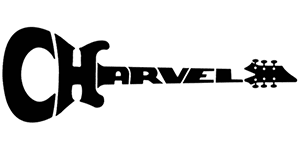
CHARVEL – EXCEPTION WHICH PROVES THE RULE
Charvel Guitar Repair
A striking example of how you can make a name not inventing the same thing all over again but simply introducing innovations into an already running process - the story of CHARVEL can serve the best example demonstrating a healthy approach. It all started in 1974 in California, when Wayne Charvel opened a guitar repair workshop calling it "Charvel Guitar Repair". However, Wayne's creative nature was alien to the ordinary restoration of instrument and he turned this process into an improvement of existing models. Fortunately, he had convincing experience in such companies as Fender and Gibson.
The workshop began production of guitar elements which also appeared to have a creative basis. The growth in demand for these services was facilitated by the fact that the guitar industry monsters Gibson and Fender didn’t accept custom orders for the production of guitars, and the demand of musicians who professed heavy metal and other "heavy" music genres wasn’t limited to the requirements for improving the performance making it easier. Many of them wanted their instrument to be distinguished by its unique sound and unique design. In some time, Charvel's instruments were recognized by such eminent guitarists as Steve Vai, George Lynch, Warren Demartini and Jake Lee. The modernization of the well-known brands have gained wide popularity. The musicians even began to give them unique names. That’s how the improved by Wayne Fender Stratocaster was given the name Superstrat. By the end of the 70's, Wayne's guitars had already been released under their own brand name, "Charvel."
METAL BOOM AND THE RECESSION
In 1978, Charvel sold the part of his company to Grover Jackson and guitars have since been produced under the brand name "Charvel by Jackson". Although Jackson did not have that skill level Charvel could boast of, he could feel the right time for introduction of something new in the guitar industry. Thanks to him the use of a new tremolo mechanism began allowing pitch change of the sound while not only decreasing but also increasing the tone.
In 1986 the company was relocated to Ontario and started a new stage in its development. The splash of popularity of the company was incited by the appearance of Jackson Randy Rhoads guitar. Randy Rhoads - Quite Riot guitarist - and Ozzy Osbourne, who needs no introduction, took part in the instrument creation process. The result of this collaboration is a deeply and thoroughly upgraded Gibson Flying V. Anyway the result turned out to be so huge and stunning that the new guitar seemed to have surpassed the original - Jackson Randy Rhoads guitar became a symbol of heavy rock.
DISTRIBUTION OR CRAWLING OFF?
Every civilization had to fall and was about to rise again – though the history amended. Along with a plummeting decline of metal music came the fall of the Charvel Guitar brand which experienced the edge of surviving at dusk. Production of guitars under Charvel brand name went to Japan, and Jackson name was put on the guitars in the United States the production of which was supervised by the International Music Corporation.
After a while in Japan, Jackson Stars and Grover Jackson brands began producing good old Jackson guitars.
In 1989 Jackson handed the ownership over to IMC. After that, the list of guitars produced under this brand was expanded, including models Warrior, Collen and others.
In 1994 the contract signed in 1986 between Grover Jackson and the Japanese company Kyowa-Shokai expired and in 2001 the Japanese company has combined all Jackson/Charvel brands into one - Jackson Stars - and now continues to make products for the domestic market.
In 2002, Akai Musical Instruments Corporation (AMIC) announced the sale of its International Music Corporation (IMC) branch to another music industry giant, Fender Musical Instruments Corporation (FMIC). Fender, thus, received the rights to products and brand names Jackson & Charvel.
After moving Jackson/Charvel to the Fender factory in Corona, California, the production of all American Jackson and Charvel guitars was focused there.
Since 2012 the manufacture of Japanese guitars for Jackson brand has been partially transferred to Indonesia and Mexico, and production of budget Charvel guitars has been moved to China.
JACKSON & CHARVEL
Nothing was heard about Grover Jackson for a long time. However, in 2012 his name came up when he announced the GJ2 brand. Today it’s a small team of like-minded people and high-profile professionals. Guitars of this brand are almost completely hand made in a small room located in the town of Laguna Hills, California and are in demand among real connoisseurs of exclusive instruments.
There is not much light shed on how the life of the company’s founder Wayne Charvel was developing after he left his creature in 1978 either. For some time he collaborated with Gibson, which released a series of guitars under the brand name Charvel. When this cooperation came to naught, Wayne made a number of attempts to re-establish the guitar production. It all started with the enterprise of W. Charvel Guitars, then he pursued with W. C. Guitars, later - Fritz Guitars, but after another failure with Wayne's Guitars in 1999, there were no other similar attempts. According to some reports, after all these vicissitudes, he simply returned to his main job at Fender, where he was happily accepted as an unrivaled master.

